Crane Rigging – Operational Tips You Cannot Afford to Ignore
Cranes are widely used for rigging purposes across the globe, be it moving or shifting any kind of heavy load. However, there’s a lot of risk associated when we talk about crane rigging. Not taking the necessary precautions and following best safety practices often result in deadly accidents and sometimes death too. So, next time when you are using a crane for rigging, take care of the following –
Know the safety requirements
To begin with, only qualified and competent personnel should operate cranes for rigging purposes. Otherwise, the consequences can be disastrous. Once you are trained to lift loads using a crane, you need to know about certain safety requirements such as the following –
- Never lift loads over areas where people are standing
- Avoid overloading the crane
- Never go for tip loading and loading on hook latch
- Side pull and end pull are a strict No
- Don’t use kinked and damaged chains for operating the crane
- Always slack up slowly and with great caution
- Don’t drag and pull the load
When it comes to positioning the crane, make sure it is absolutely perpendicular to the load that is to be carried. Avoid non-vertical lifts as it can lead to substantial crane and materials damage.
Sling position
Slings are widely used along with crane lifts for various rigging purposes. Therefore, as an operator you must know how to use these safely and properly. Generally, there are two types of slings used namely nylon and wire mesh. If mishandled, slings lead to workplace disasters. Slings can be used in three ways. Each sling has its own weight limit for choker, basket or vertical configurations. Choker configuration has the least rated capacity with basket configuration having the maximum. So, next time you are about to lift a load consider these sling positions too.
Weight and angle
Always remember, the angle at which the sling holds the load directly influences the load-weight. Slings that are held perpendicular to the load experience minimum stress. For a vertical load distribution, you can use a spreader bar as well. As you increase the sling’s angle to the hook, the effective load-mass also shoots up considerably. It actually doubles the weight on each end of the sling. Therefore, you are advised to consult an engineer or take a look at charts provided by your employer regarding this. In order to prevent accidents/mishaps, limit the sling’s angle.
Understanding the signals
Deciphering hand signals is particularly very important when it comes to crane lifting and rigging. Due to some surrounding noise, it might be difficult for an operator to hear instructions. Hence, the need to understand hand signals. Also, operators should follow hand signals from only one person. Never move the crane unless you are 100% clear of the signals. Here are some of the standard signals used –
- A position that is hold rigidly with an extended arm and palm down indicates STOP immediately.
- A horizontal hand wave of the extended arm implies EMERGENCY STOP.
- To indicate MOVE SLOWLY, you can use a hand to give motion signal and use the other one motionlessly in front of the hand that is offering the motion signal.Similar to these hand signals, there are signals for indicating trolley travel, bridge travel and much more.
Crane rigging is an extremely dangerous activity. Never do it without proper training and qualification. Follow OSHA’s regulations regarding crane operations to stay safe at your workplace.
Shop Online















